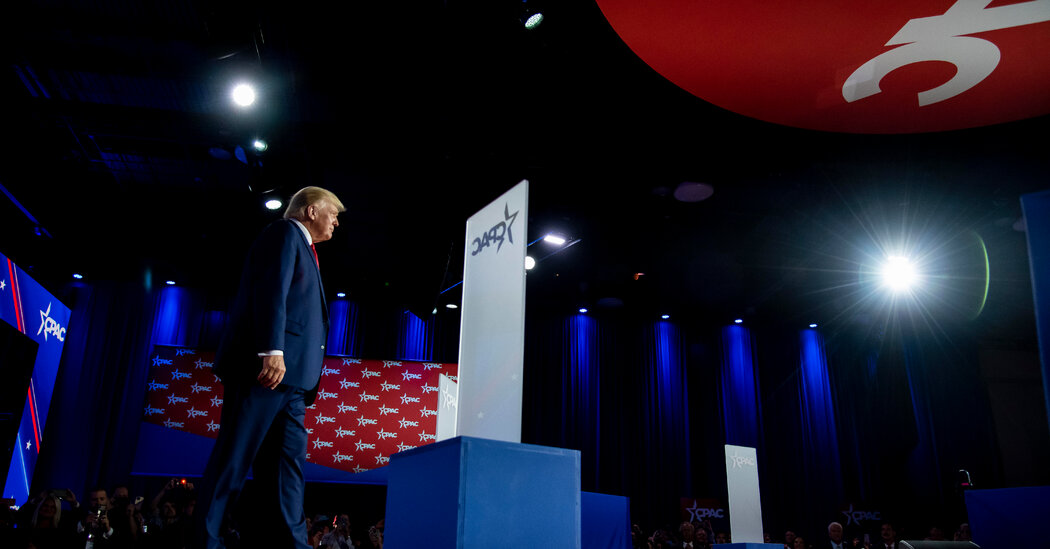
Attorney General Merrick B. Garland moved on Thursday to make public the legal authorization for the F.B.I.’s search of former President Donald J. Trump’s home in Florida, which was carried out as part of the government’s effort to account for documents that one person briefed on the matter said related to some of the most highly classified programs run by the United States.
Mr. Garland said he had personally approved the search after the failure of “less intrusive” attempts to retrieve material taken from the White House by Mr. Trump.
Mr. Garland provided no details. But the person briefed on the matter said investigators had been concerned about material from what the government calls “special access programs,” a designation that is typically reserved for extremely sensitive operations carried out by the United States abroad or for closely held technologies and capabilities.
Government officials have expressed concern that allowing highly classified materials to remain at Mr. Trump’s home could leave them vulnerable to efforts by foreign adversaries to acquire them, according to another person familiar with the Justice Department’s thinking.
Late on Thursday night, Mr. Trump said he would not oppose the motion to release the warrant and the inventory.
He wrote on his social media site, Truth Social, that he was “encouraging” their release. “Release the documents now!” he said.
In a clipped, two-minute statement to reporters at the Justice Department’s headquarters, Mr. Garland said he decided to break his silence and make a public statement because Mr. Trump had disclosed the action himself. The attorney general also cited the “surrounding circumstances” of the case and the “substantial public interest in this matter.”
But Mr. Garland also used the brief appearance to defend, at least implicitly, the Justice Department’s handling of the case against the torrent of criticism directed at it by Mr. Trump and his allies.
“Upholding the rule of law means applying the law evenly, without fear or favor,” Mr. Garland said. “Under my watch that is precisely what the Justice Department is doing.”
Minutes before Mr. Garland took the podium, a top official in the Justice Department’s national security division filed a motion to unseal the search warrant and an inventory of items retrieved in the search on Monday.
More Coverage of the F.B.I. Search of Trump’s Home
While the inventory provided to Mr. Trump’s team after the search is unlikely to reveal details about the specific documents he kept, it refers to an array of sensitive material, according to a person with knowledge of the matter.
Judge Bruce Reinhart, the federal magistrate in the Southern District of Florida who approved the search warrant and is handling the motion to unseal it, had issued an order requiring the Justice Department to serve a copy of its motion to Mr. Trump’s lawyers. It said the department would have to tell the judge by 3 p.m. on Friday whether Mr. Trump opposed the motion.
Mr. Garland’s statement amounted to a challenge to Mr. Trump, who has been free to release the search warrant and the list of items taken during the search on his own, but has declined to do so. Many Trump allies and Republicans have also called on Mr. Garland to explain his decision, adding political complexity — or hypocrisy — to any decision by Mr. Trump to oppose making the search warrant public.
The Justice Department did not seek to release the affidavits — which contain much more information about the behavior of Mr. Trump and evidence presented by others — that were used to obtain the warrant.
The public statement by Mr. Garland came at an extraordinary moment, as a sprawling set of investigations into the former president on multiple fronts gained momentum even as Mr. Trump continued to signal that he might soon announce another run for the White House.
Mr. Trump invoked his Fifth Amendment right against self-incrimination on Wednesday in a civil investigation into his business practices by the New York attorney general, and a close ally in the House had his phone seized by federal agents this week in one strand of the investigation into Mr. Trump’s efforts to remain in power despite his election loss in 2020.
Mr. Garland also spoke on the same day that law enforcement officers shot and killed a man who they said tried to break into the F.B.I.’s Cincinnati office on Thursday. Investigators were looking into whether he had ties to extremist groups, including one that participated in the Jan. 6 attack on the Capitol, according to two law enforcement officials familiar with the matter.
The search on Monday of Mr. Trump’s home at Mar-a-Lago, his private club, was the most explosive development yet in the various inquiries. The investigation centers on whether he improperly took sensitive materials with him from the White House when his term ended and then failed to return all of them — including classified documents — when the National Archives and the Justice Department demanded that he do so.
Months before the F.B.I. arrived at Mar-a-Lago, Mr. Trump had received a subpoena this spring in search of documents that federal investigators believed he had failed to turn over earlier in the year, when he returned 15 boxes of material to the archives, three people familiar with the matter said.
The existence of the subpoena helps to flesh out the sequence of events that led to the search, and suggests that the Justice Department tried methods short of a search warrant to account for the material before taking the politically explosive step of sending F.B.I. agents unannounced to Mar-a-Lago.
Mr. Garland did not address a subpoena during his appearance on Thursday, but said that “where possible, it is standard practice to seek less intrusive means,” indicating that other measures were tried before a search took place.
What we consider before using anonymous sources. How do the sources know the information? What’s their motivation for telling us? Have they proved reliable in the past? Can we corroborate the information? Even with these questions satisfied, The Times uses anonymous sources as a last resort. The reporter and at least one editor know the identity of the source.
Two people briefed on the classified documents that investigators believed remained at Mar-a-Lago indicated that they were so sensitive, and related to national security, that the Justice Department had to act.
The subpoena was first disclosed by John Solomon, a conservative journalist who has also been designated by Mr. Trump as one of his representatives to the National Archives.
The existence of the subpoena is being used by allies of Mr. Trump to make a case that the former president and his team were cooperating with the department in identifying and returning the documents in question and that the search was unjustified.
Christina Bobb, a lawyer for Mr. Trump, did not respond to messages. It is not clear what precise materials the subpoena sought or what documents the former president might have provided in response.
The subpoena factored into a visit that Jay Bratt, the Justice Department’s top counterintelligence official, made with a small group of other federal officials to Mar-a-Lago in early June, one of the people said.
The officials met with Mr. Trump’s lawyer, Evan Corcoran. Mr. Trump, who likes to play host and has a long history of trying to charm officials inquiring about his practices, also made an appearance. During the visit, the officials examined a basement storage area where the former president had stowed material that had come with him from the White House.
A few days after the visit, Mr. Bratt emailed Mr. Corcoran and told him to further secure the remaining documents, which were kept in the storage area with a stronger padlock, one of the people said. The email was reported earlier by The Wall Street Journal.
Then, they subpoenaed surveillance footage from the club, which could have given officials a glimpse of who was coming in and out of the storage area, according to a person with knowledge of the matter. They received footage specifically from areas of the club where they believed the documents might have been stored, the person said.
During the same period, investigators were in contact with a number of Mr. Trump’s aides who had some visibility into how he stored and moved documents around the White House and who still worked for him, three people familiar with the events said.
Among those whom investigators reached out to was Molly Michael, Mr. Trump’s assistant in the outer Oval Office who also went to work for him at Mar-a-Lago, three people familiar with the outreach said.
Investigators have also reached out to Derek Lyons, the former White House staff secretary, whose last day was Dec. 18, 2020, and no longer works for Mr. Trump, with questions about the process for handling documents, according to a person familiar with the outreach.
Federal officials came to believe that Mr. Trump had not relinquished all the material that left the White House with him at the end of his term, according to three people familiar with the investigation.
Less than two months later after Mr. Bratt and the other officials visited Mr. Trump’s home, about two dozen F.B.I. agents, intentionally not wearing the blue wind breakers emblazoned with the agency’s logo usually worn during searches, appeared at Mar-a-Lago with a warrant.
The club was closed; Mr. Trump was in the New York area; the F.B.I. startled a crew fixing a large fountain, a maid who was dusting and a handful of Secret Service agents who guard the complex.
The search warrant was broad, allowing the agents to investigate all areas of the club where classified materials might have been stored. They went through the basement, Mr. Trump’s office and at least part of his residence at the club.
After hours of searching, they left with several boxes that were not filled to the brim and in some cases simply contained sealed envelopes of material that the agents took, one person familiar with the search said.
The person said the F.B.I. left behind a two-page manifest of what was taken. If the manifest is made public, it is likely to be heavily redacted to shield any classified material.
Some senior Republicans have been warned by allies of Mr. Trump not to continue to be aggressive in criticizing the Justice Department and the F.B.I. over the matter because it is possible that more damaging information related to the search will become public.
When Mr. Trump left the White House, he took with him boxes containing a mishmash of papers, along with items like a raincoat and golf balls, according to people briefed on the contents. The National Archives tried for months after Mr. Trump left office to retrieve the material, engaging in lengthy discussions with his representatives to acquire what should have been properly stored by the archives under the Presidential Records Act.
When archivists recovered 15 boxes this year, they discovered several pages of classified material and referred the matter to the Justice Department. Officials later came to believe that additional classified material remained at Mar-a-Lago.
During his appearance on Thursday, Mr. Garland, a former midlevel prosecutor, went out of his way to counter claims by Mr. Trump and his supporters that agents with the bureau or Justice Department lawyers were motivated by politics or behaved inappropriately in the course of requesting and executing the search warrant.
“I will not stand by silently when their integrity is unfairly attacked,” Mr. Garland said.
Christopher A. Wray, the F.B.I. director, said in an internal email earlier in the day that he would adjust the bureau’s “security posture” as needed. He also defended the work of the agents involved in the Trump case.
“We don’t cut corners,” he wrote. “We don’t play favorites.”




